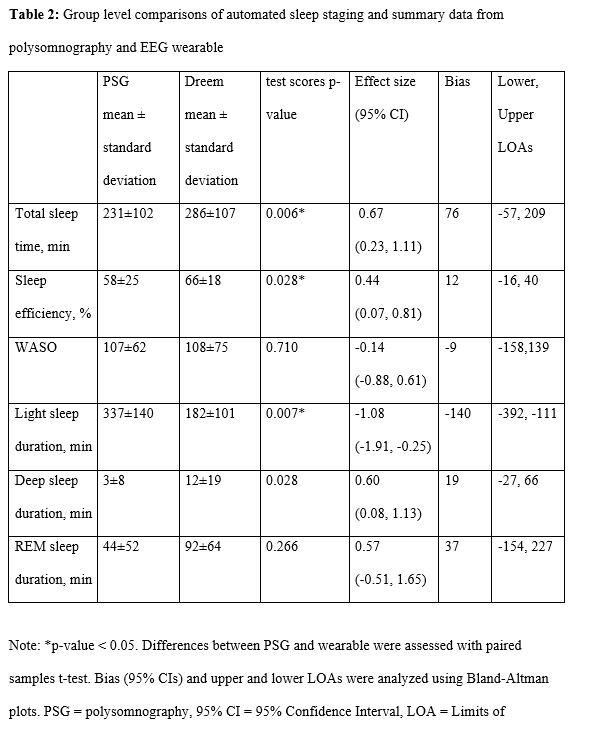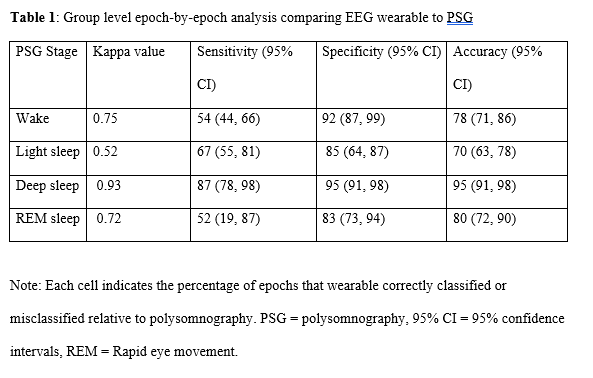Category: Technology
Objective: To evaluate the performance of a consumer-grade EEG device compared against polysomnography (PSG) in individuals with Parkinson’s disease (PD).
Background: Sleep disturbance is an important, but often under-monitored, non-motor symptom of PD. Commercial wearable technology available to the public may help broaden surveillance but has not been fully validated in PD. Establishing performance metrics against gold-standard PSG will inform clinical and research use.
Method: Ten participants (Mage = 69.5, 30% female) with early-stage PD (Hoehn & Yahr = 1-2) wore an EEG wearable during PSG. The wearable device adjusts over the participant’s hair, with 5 dry electrodes and 4 channels (FpZ-O1, FpZ-O2, F7-O1, or F8-O2), accelerometer, and pulse sensor. An accompanying app captures sensor output over a wireless network, which is processed to derive sleep metrics and staging. The wearable was placed after placement PSG electrodes, with care for nonoverlap. Epoch-by-epoch (EBE) analyses of thirty second periods were performed following synchronization with PSG. Group-level accuracy, sensitivity, and specificity for sleep staging with 95% CIs were calculated. Sleep metrics derived from the wearable and PSG were compared using Wilcoxon signed rank tests.
Results: Across all stages, accuracy was adequate (>.70), and strongest for deep sleep and REM sleep. Across all stages, specificity was strong and higher than sensitivity. When considering the lower CI bounds, sensitivity was only appropriate for deep and light sleep. Across all stages, accuracy was adequate (>.70), particularly for deep sleep and REM sleep. Across all stages, specificity was strong and higher than sensitivity; sensitivity was only appropriate for deep and light sleep. The wearable significantly overestimated total sleep, efficiency, deep sleep, and REM sleep. It significantly underestimated light sleep.
Conclusion: This pilot study demonstrates that a commercial EEG wearable has similar performance metrics in individuals with PD as it does with healthy adults. As such, it holds promise for helping track sleep function in PD and is worthy of further research.
To cite this abstract in AMA style:
D. González, D. Wang, E. Pollet, A. Velarde, S. Horn, J. Ramirez-Castaneda, P. Coss, O. Vaou, J. Wang, C. Li, S. Seshadri, H. Miao, M. Gonzales. Performance of commercial EEG wearable for sleep classification in Parkinson disease [abstract]. Mov Disord. 2023; 38 (suppl 1). https://www.mdsabstracts.org/abstract/performance-of-commercial-eeg-wearable-for-sleep-classification-in-parkinson-disease/. Accessed December 17, 2025.« Back to 2023 International Congress
MDS Abstracts - https://www.mdsabstracts.org/abstract/performance-of-commercial-eeg-wearable-for-sleep-classification-in-parkinson-disease/


